 |
|
|
|
Thu, 25 Apr, 2024
|

|

|
|
? Lavender |
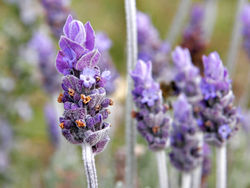
Lavender flowers
|
| Scientific classification |
| Kingdom: |
Plantae
|
| Division: |
Magnoliophyta
|
| Class: |
Magnoliopsida
|
| Order: |
Lamiales
|
| Family: |
Lamiaceae
|
| Genus: |
Lavandula
L. |
|
|
|
|
|
|
Species
|
About 25-30, including:
Lavandula angustifolia
Lavandula canariensis
Lavandula dentata
Lavandula lanata
Lavandula latifolia
Lavandula multifida
Lavandula pinnata
Lavandula stoechas
Lavandula viridis
|
The lavenders Lavandula are a genus of about 25-30 species of flowering plants in the mint family, Lamiaceae, native from the Mediterranean region south to tropical Africa and east to India. The genus includes annuals, herbaceous plants, subshrubs, and small shrubs. The native range extends across the Canary Islands, North and East Africa, south Europe and the Mediterranean, Arabia, and India. Because the cultivated forms are planted in gardens world-wide, they are occasionally found growing wild, as garden escapes, well beyond their natural range.
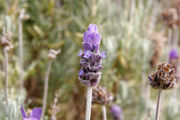 Lavender flower
|
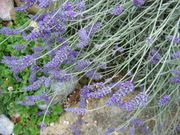 Lavender flowers
|
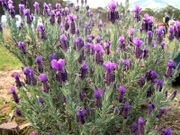 Lavandula stoechas
|
 Jump to Page Contents Jump to Page Contents
|
|

Pay as you go
No monthly charges. Access for the price of a phone call
Go>
Unmetered
Flat rate dialup access from only £4.99 a month Go>
Broadband
Surf faster from just £13.99 a month Go> |
Save Even More
Combine your phone and internet, and save on your phone calls
More Info> |
This weeks hot offer
 24: Series 5
24: Series 5
In association with Amazon.co.uk £26.97 |
|
Contents
 Cultivation and uses Cultivation and uses
 Cultivation and uses - Contents Cultivation and uses - Contents
The most common species in cultivation is the Common Lavender Lavandula angustifolia (formerly L. officinalis). A wide range of cultivars can be found. Other commonly grown ornamental species are L. stoechas, L. dentata, and L. multifida.Lavenders are much grown in gardens. Flower spikes are used for dried flower arrangements. The fragrant, pale purple flowers and flower buds are used in potpourris. Dried and sealed in pouches, they are placed among stored items of clothing to give a fresh fragrance and as a deterrent to moths. The plant is also grown commercially for extraction of lavender oil from the flowers. This oil is used as an antiseptic and for aromatherapy.Lavender flowers yield abundant nectar which yields a high quality honey for beekeepers. Lavender honey is produced primarily in the nations around the Mediterranean, and marketed worldwide as a premium product. Lavender flowers can be candied and are used as cake decoration. Lavender is also used as a herb, either alone or as an ingredient of herbes de Provence.
History
The ancient Greeks called the lavender herb nardus, after the Syrian city of Naarda. It was also commonly called nard.During Roman times, flowers were sold for 100 denarii per pound, which was about the same as months wage for a farm labourer or 50 haircuts from the local barber. Lavender was commonly used in Roman baths to scent the water, and it was thought to restore the skin. When the Roman Empire conquered southern Britain, the Romans introduced lavender.During the height of the Plague, glove makers at Grasse would scent their leathers with lavender oil, and this was claimed to ward off the Plague. This story could have some validity as the Plague was transmitted by fleas, which lavender is known to repel.
Herbal Remedies
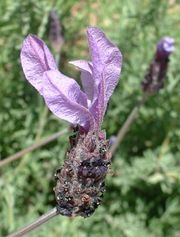 Flower of cultivated lavender; Lavandula stoechas or Spanish lavender
Lavender has been extensively used in herbalism. An infusion of lavender is claimed to soothe and heal insect bites. Bunches of lavender are also said to ward off insects. If applied to the temples, lavender oil is said to soothe headaches. Lavender is frequently used as an aid to sleep: Seeds and flowers of the plant are added to pillows, and an infusion of three flowerheads added to a cup of boiling water are recommended as a soothing and relaxing bedtime drink. Lavender oil (or extract of Lavender) is claimed to heal acne when used diluted 1:10 with water, rosewater, or witch hazel; it is also used in the treatment of skin burns and inflammatory conditions (it is a traditional treatment for these in Iran). There is scientific evidence to support the effectiveness of some of these remedies, especially the anti-inflammatory effects, but they should be used with caution since lavender oil can also be a powerful allergen. |
Change Text Size:
[A]
[default]
[A] |




 |
|
|
|
|